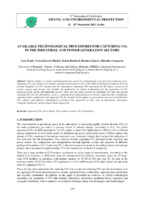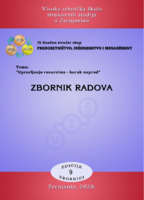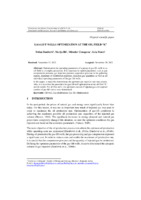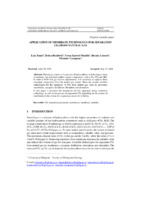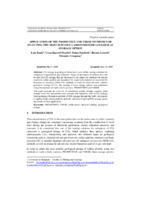Претрага
7 items
-
Available technological procedures for capturing CO2 in the industrial and power generation sectors
Climate change is a major environmental issue caused by anthropogenic emissions of greenhouse gases. Capturing CO2 and storing it in suitable geological formations is one of the main technological solutions that can provide mitigation of CO2 emission into the atmosphere. Capturing CO2 represents the first phase in process of carbon capture and storage, and includes the application of various technologies for the separation of CO2 produced in the energy and industrial sectors. There are four main systems for capturing ...Lola Tomić, Vesna Karović Maričić, Dušan Danilović, Branko Leković, Miroslav Crnogorac. "Available technological procedures for capturing CO2 in the industrial and power generation sectors" in 8th International Conference Mining and Environmental Protection, 22 – 25th September 2021, Serbia, Univerzitet u Beogradu, Rudarsko-geološki fakultet (2021)
-
Upravljanje proizvodnjom nafte – novi alat na bazi fazi logike
Мирослав Црногорац, Душан Даниловић, Лола Томић. "Upravljanje proizvodnjom nafte – novi alat na bazi fazi logike" in IX Naučno stručni skup Preduzetništvo, inženjerstvo i menadžment Zrenjanin, 24.10.2020. god., Visoka tehnička škola strukovnih studija u Zrenjaninu (2020)
-
Criteria for CO2 storage in geological formations
Tomić Lola, Karović-Maričić Vesna, Danilović Dušan, Crnogorac Miroslav. "Criteria for CO2 storage in geological formations" in Podzemni radovi no. 32, Beograd:Univerzitet u Beogradu, Rudarsko-geološki fakultet (2018): 61-74
-
Gas-lift wells optimization at the oil field "K"
Dušan Danilović, Marija Ilić, Miroslav Crnogorac, Lola Tomić. "Gas-lift wells optimization at the oil field "K"" in Podzemni radovi, University of Belgrade - Faculty of Mining and Geology (2022). https://doi.org/10.5937/podrad2241031D
-
Application of Membrane Technology for Separation CO2 from Natural Gas
Natural gas consists of a mixture of hydrocarbons with the largest share of methane, and non-hydrocarbon impure components such as N2, CO2 and H2S. In order to fulfill the gas market requirements, it is necessary to separate these unwanted components from the natural gas stream. There are several available technologies for the separation of CO2 from natural gas, such as: polymeric membranes, cryogenic distillation, absorption and adsorption. In this paper is presented the mechanism of CO2 separation using membrane technology, ...Lola Tomić, Dušan Danilović, Vesna Karović Maričić, Branko Leković, Miroslav Crnogorac. "Application of Membrane Technology for Separation CO2 from Natural Gas" in Underground Mining Engineering, Belgrade : University of Belgrade - Faculty of Mining and Geology (2020)
-
Application of the PROMETHEE and VIKOR methods for selecting the most suitable carbon dioxide geological storage option
CO2 storage in geological formations is one of the leading solutions for mitigation of greenhouse gas emissions. Types of geological formations that can be used for CO2 storage, that are discussed in this paper are: depleted oil and gas reservoirs, saline aquifers and injection CO2 in partially depleted oil reservoirs for enhanced oil recovery (EOR–CO2 method). In order to select the most suitable geological storage of CO2, the ranking of these storage options was performed using two methods of ...Lola Tomić, Vesna Karović Maričić, Dušan Danilović, Branko Leković, Miroslav Crnogorac. "Application of the PROMETHEE and VIKOR methods for selecting the most suitable carbon dioxide geological storage option" in Underground Mining Engineering, Belgrade : University Of Belgrade - Faculty of Mining and Geology (2019)
-
The preliminary selection of oil reservoir in Serbia for carbon dioxide injection and storage by a multicriteria decision-making approach: a case study
Lola Tomić, Vesna Karović Maričić, Dušan Danilović. "The preliminary selection of oil reservoir in Serbia for carbon dioxide injection and storage by a multicriteria decision-making approach: a case study" in Energy Sources, Part A: Recovery, Utilization, and Environmental Effects, Taylor & Francis (2021). https://doi.org/10.1080/15567036.2021.1936303
